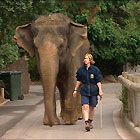This week, Don and the Burke’s Backyard team visited Melbourne Zoo. This was the perfect place to introduce viewers to a new member of our team, veterinarian, Dr Chris Brown. In future Chris will be doing the vetcheck section of roadtests and presenting veterinary segments.
Historic zoo
Melbourne Zoo is Australia’s oldest – it was modelled on London Zoo and opened in 1862. However, the old circus cages, brick enclosures and cast iron bars of the past are long gone. Melbourne Zoo has a master plan to display animals in a series of bioclimatic, or habitat zones. They include an African Rainforest with Western Lowland Gorillas, Pygmy Hippopotamus and Mandrills; an Asian Rainforest with Sumatran Tigers; and Australian Bush, featuring Red Kangaroos and Southern Hairy-Nosed Wombats.
Elephant village
The Asian elephants at Melbourne Zoo live in a lush, rainforest environment. 120 plant species and 31,000 plants have been used in the landscaping, including mature trees. 800 cubic metres of ZooGro (recycled animal and plant waste) were used in the exhibit. Don was interested to see the dry, fibrous droppings of an elephant. A healthy adult elephant produces an amazing 50kgs of poo every day. Don enjoyed feeding and interacting with the elephants, and watching them play around the pool in their enclosure. Elephants usually sleep for only about four hours out of 24, and require a range of activities to keep them stimulated.
Tropical garden
The landscaping at Melbourne Zoo is a wonderful example of how to plant a tropical-style foliage garden in a cooler climate. You can achieve this effect with plants such as white ginger lily (Hedychium coronarium), Renga renga lily (Arthropodium cirratum), umbrella tree (Schefflera actinophylla), New Zealand flax (Phormium tenax ‘Maori Chief’), trevesia (Trevesia palmata) and canna (Canna ‘Tropicanna’).
Seal pool
The seal pool includes an underwater viewing area for Australian Fur Seals. One of the seals shown in our segment was rescued after being caught in a trawler net – horrific scars are still visible around its neck.
Red-Tailed Black-Cockatoo
The Red-Tailed Black-Cockatoo is usually found in eucalypt woodland and along water courses, but these beautiful birds are threatened by clearing of their habitat. An interesting bit of trivia is that these cockatoos all seem to be left footed – they always use their left foot to hold onto things.
Tree kangaroos
Don fed some mushrooms to a Goodfellow



